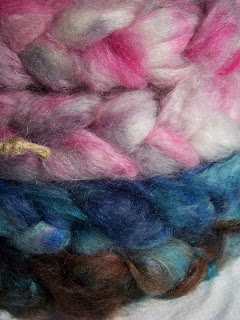To make goat cheese you need:
- goat's milk (I use Meyenberg Vitamin D)
- white vinegar
- cheese salt
- exceptionally clean wash cloth
- fine mesh strainer
- medium bowl
- a medium pot
- thermometer
Start adding vinegar a little at a time until the curds start to separate. If you add too much vinegar, (within reason) no worries, it will be strained out when the curds are collected.
Rinse your wash cloth, especially if you use fabric softener. (You don't want Downey scented cheese, ha!) Lay the washcloth flat against the strainer over a bowl.
Pour the curds, whey and vinegar through the cloth. You will have to use a spoon to scrape the bottom so the whey can continue to pass. The curds will "clog" the pores of the washcloth so you have to keep that moving. I think a wash cloth works better than cheesecloth because the curds are really small and you can trap more in a wash cloth.
When a good amount of the liquid is gone, you can gather the edges of the cloth and squeeze more liquid out. The more liquid you remove, the dryer the cheese will be.
Once you've reached the desire consistency you can begin to flavor the cheese. I stat by adding a tsp of salt at a time, mixing and tasting until I like the flavor. I add herbs in the same manner. As the cheese cools it will become more flavorful.
Zach and I save little wooden cheese boxes and recycle them for all kinds of reasons. I take a cheese box, line it with plastic wrap or wax paper and press the cheese into the wheel, then fold the plastic over the top.
I really like goat cheese with sweet flavors. Try stuffing dates with goat cheese or on salads with sweeter dressings like poppy seed.
As a side note, I got an excellent reader question sent to me via e-mail and I thought I should answer it here just in case others were wondering the same.
Roberta from New Hampshire wants to know why we had to buy goats milk. She asks, "why don't we just milk our own goats."
That's a great question. In fact, eight years ago when I first started looking into Angora Goats, I was all excited to invest in a "multi-purpose" animal, and I must say, I was slightly disappointed to learn that we wouldn't be able to shear and milk them. I'll start with a little goat anatomy lesson.
First off, you must breed an animal for it to produce milk. Just like a lady, our bodies don't just start producing milk, we must first become pregnant. A goat, on average, will produce milk for about a year after her offspring is born, long after the offspring is weaned. Then she must be bred again to continue producing.
Because we didn't breed our girls last Fall (long story) there's no way we could milk them.
Secondly, we don't have dairy goats. Our goats aren't even considered multi-purpose like a meat goat that could be milked, or a cross. Angoras are considered a delicate breed in the goat world. This comes from all the fiber that their body produces. Their bodies have to work hard to produce all that fiber, sometimes at the cost of producing milk for their offspring. When a mother Angora is lactating her body is under a good amount of stress and many times her fleece will stunt. So unfortunately, Angoras don't have any milk to spare for us. Now dairy goats, have been known to produce between a gallon to a gallon and a half a day.....hmmm...now there's an idea!






















































